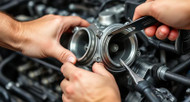Step-by-Step Guide to Installing a Turbo Manifold
Posted by SS Auto Chrome on 29th Apr 2025
Installing a turbo manifold is major step in boosting engine performance. Finishing this part of the project correctly is important for power delivery, air flow, and long-term dependability, no matter if you're building a race car or tuning a street car. This guide walks through each stage, offering a practical outline for those who want to install a turbo setup without cutting corners.
Before you begin, make sure the turbo kit you're using is compatible with your engine type and exhaust configuration. A solid plan and the appropriate tools can help you save time in the garage while also protecting engine components.
Preparing the Vehicle for Installation
- Disconnect the Battery: Always begin by disconnecting the negative terminal of your battery to avoid electrical shorts while working near the engine.
- Lift the Vehicle (if needed): Depending on the layout of your vehicle, you may need to lift the front end to gain better access to the engine's exhaust side.
- Remove Factory Exhaust Manifold: Take out the stock exhaust manifold, heat shields, and related hardware. Penetrating oil and patience are helpful when dealing with stubborn bolts. This is an essential step before installing a turbo kit.
- Clean the Surface: After removing the manifold, clean the cylinder head surface to ensure a proper seal for the new manifold gasket.
Fitting the Turbo Manifold
- Test Fit the Manifold: Before tightening anything, test fit the turbo intake manifold to ensure clearance for surrounding components such as radiator fans, engine mounts, and lines.
- Install New Gasket: Always use a new manifold gasket. Once the manifold is in position, line it up carefully to prevent leaks.
- Bolt On the Turbo Manifold: Use the correct torque sequence and values specified by your vehicle or manifold manufacturer. Uneven torque can cause warping or leaks. This step is critical for anyone looking to install turbo components properly.
Mounting the Turbocharger
- Install the Turbo onto the Manifold: With the manifold in place, mount the turbocharger. Make sure every mating surface is clean and free of debris.
- Secure the Turbo: Use locking nuts and appropriate gaskets, or V-band clamps (depending on your setup). This guarantees a strong link and lessens the possibility of fasteners backing out under heat cycling.
- Clock the Turbo (if necessary): Some turbochargers allow you to rotate the compressor or turbine housing to match your vehicle’s plumbing. Make adjustments as needed for proper fitment.
Oil and Coolant Lines
- Install Oil Feed Line: Connect the oil feed line to the turbo from the oil source. This could call for a sandwich plate, or oil filter housing tapping.
- Install Oil Return Line: The return line must flow downward from the turbo into the oil pan. Some pans need to be modified or tapped for a fitting. Make sure there are no kinks or blockages..
- Coolant Lines (if water-cooled): Some turbos require coolant. Connect coolant feed and return lines if your turbo uses them. Double-check for tight fittings and secure hose clamps.
Connect the Downpipe and Exhaust
- Install the Downpipe: Line up the turbo’s outlet with the downpipe. Secure the connection using a gasket or V-band clamp, depending on your kit. A correct alignment is necessary to keep the manifold, or turbo flange from being stressed.
- Connect to Exhaust System: Run your exhaust system down the downpipe. To avoid exhaust leaks and vibrations, adjust for clearance and support as required.
Intercooler and Intake Setup
- Attach the Charge Pipes: The pipes should run from the turbo outlet to the intercooler, then to the intake manifold. Use T-bolt clamps to tie down all of the couplers.
- Install Blow-Off Valve and Boost Controller: Mount the blow-off valve on the charge piping and route vacuum lines. A manual or electronic boost controller can help manage target boost levels.
- Install the Air Intake: Connect an air filter and connect the intake pipes to the compressor inlet of the turbo. Make sure it is not near an engine that is getting too hot.
Tuning and Final Checks
- Check All Fasteners: Check each latch, clamp, and bolt. Make sure that everything is properly torqued and that nothing was missed when it was put together.
- Refill Fluids: Refill the engine oil and coolant if any were lost during installation.
- Tune the ECU: This step is essential after you install turbo hardware. Safe air-fuel ratios, ignition timing, and boost levels are all checked by a tune. Without a proper tune, even a well-installed turbo auto spare parts setup can damage your engine.
- Start the Engine and Inspect: Check for leaks, or strange noises while the engine is at idle. Listen for exhaust leaks and keep an eye on the oil pressure. After everything appears to be in order, test drive with a light throttle while keeping an eye on performance.
Staying on Track
Knowing how to install a turbo and paying close attention to each step can mean the difference between a successful build and frequent trips to the garage. This general procedure applies to the majority of vehicles and the safe installation of a turbo kit, though each setup may have its own particular layout or obstacles.
If you’re taking on this project yourself, patience and planning are key. And when in doubt, reaching out to experienced installers or tuning specialists is always a smart move.

